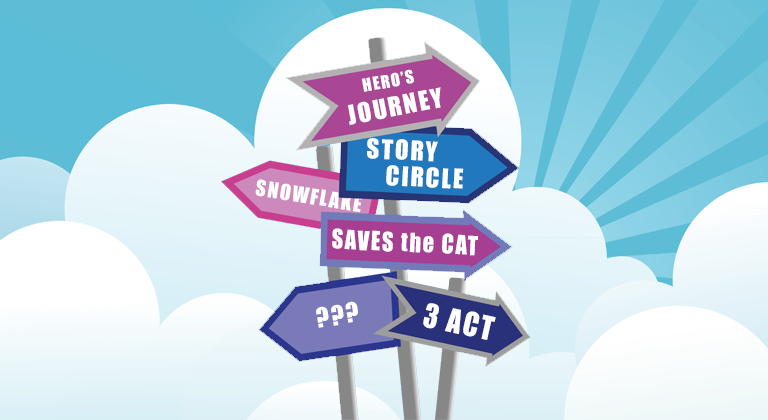Using Story Structures to Write Better Books
Many non-authors believe that writing a book is as straightforward as jotting down a lengthy email or drafting a report. Yet, as any author who has actually written a novel can attest, there is a big difference between everyday writing and crafting narratives that captivate and entertain readers for hundreds of pages. Perhaps the misconception comes because, unlike the specialized skills required for performing surgery or practicing law, writing seems accessible to everyone and a part of our daily lives. However, this perception ignores the artistry and dedication that goes into weaving compelling stories from the simple thread of imagination.
That’s why today, Ginger is shining a spotlight on the scaffolding behind the scenes of great storytelling—the story structures. Structures are the story frameworks that can help guide an author from the germ of an idea to a fully fleshed-out narrative. And just as there are many different ways to tell a story, there are many different story structures to help guide the way, with Ginger digging into five of the more popular ones: “The Hero’s Journey,” “The Three-Act Structure,” “The Story Circle,” “Save the Cat,” and “The Snowflake Method.” Each structure offers a unique framework to build your story around, and can be a useful tool in the writer’s arsenal to help them go from a simple idea to a finished book, without missing any important stops along the way.
One source of frustration that many self-published authors have is the perception of how “easy” writing is – with a lot of friends and family musing openly that “I should write a book one of these days.”
This impression comes from the fact that writing is, on the surface, something most of us can do once we’ve graduated middle school – but there’s a great deal of difference between being able to write an email or a shopping list, and crafting a full-length, satisfying novel.
As anybody who’s studied the craft knows, writing involves a lot more than just putting words on a page. The story that you write has to take the reader on a journey, with emotional ups and downs and a final, satisfying conclusion. This requires not just understanding the structure of storytelling, but also figuring out a way to fit your narrative – what happens in your story – into a framework that makes it compelling to read about and experience.
What elevates a successful self-published author above somebody who just “thinks they should write a book one of these days” is understanding and implementing effective story structures – and in this week’s blog post, I wanted to explore some of the most popular and well-known story structures, including what makes each of them unique and how self-published authors can choose between them to craft more effective stories.
The Hero’s Journey: Joseph Campbell’s Timeless Template
Even casual writers who think “I should write a story one of these days” are probably familiar with one of the most famous story structures: Joseph Campbell’s The Hero’s Journey. It’s a structure that can be identified in classic tales ranging from Lord of the Rings to the original Star Wars movies, and continues to influence fantasy and adventure authors worldwide.
The reason The Hero’s Journey is so wide-spread and well known is because Joseph Campbell didn’t actually invent it himself. Born in 1904, Campbell was an American mythologist, writer, and lecturer who became known for his work in comparative mythology. His groundbreaking book The Hero with a Thousand Faces, published in 1949, explored the concept of “the hero’s journey” and the common elements found in myths, legends, and religious stories from various cultures around the world. It was from this exploration that he isolated what many authors today call “the monomyth” or the hero’s journey: a narrative pattern that he believed was present in the mythology of countless different cultures all throughout history.
According to Campbell, the hero’s journey consists of several key stages:
- The Call to Adventure: The hero receives a call to leave their ordinary world and embark on a quest or adventure.
- Refusal of the Call: Initially, the hero may be hesitant or reluctant to accept the call.
- Supernatural Aid: The hero often receives assistance or guidance from a mentor figure or a supernatural force.
- The Crossing of the First Threshold: The hero leaves their ordinary world and enters the unknown or a new, challenging realm.
- Belly of the Whale: The hero faces a significant ordeal or crisis that marks their symbolic death and rebirth.
- The Road of Trials: The hero encounters a series of challenges and tests that contribute to their personal growth and transformation.
- Meeting with the Goddess/Atonement with the Father: The hero experiences a profound connection with a feminine or maternal figure, and they reconcile with their paternal or authoritative figure.
- Apotheosis: The hero achieves a higher state of being or understanding, often transcending their previous limitations.
- The Ultimate Boon: The hero attains the ultimate goal of their quest, whether it be knowledge, power, or an object of great importance.
- Refusal of the Return: The hero may be reluctant to return to the ordinary world, having found a new sense of purpose or enlightenment.
- The Magic Flight: The hero faces challenges as they return to the ordinary world, often with the newfound boon.
- Rescue from Without: The hero receives external help or assistance during the final stages of their journey.
- The Crossing of the Return Threshold: The hero returns to the ordinary world, bringing back the wisdom or gifts acquired during their journey.
- Master of Two Worlds: The hero has integrated the lessons learned during their journey into both the ordinary and the extraordinary realms.
Although Campbell didn’t invent the monomyth, his work was perhaps the first time it had been deconstructed so directly, and has since had a profound influence on storytelling, literature, and filmmaking, with many writers and filmmakers adopting and adapting the hero’s journey as a fundamental structure for their narratives. The concept continues to be taught as a valuable tool for understanding the universal elements of storytelling and character development.
For example, J.K. Rowling’s Harry Potter series wouldn’t exist without The Hero’s Journey. Young Harry, the eponymous hero, starts his saga by hearing “the call to adventure” when he discovers he’s a wizard, and then he continues through the other stages of Campbell’s monomyth as he faces various challenges at Hogwarts. Harry undergoes significant personal growth through the seven-book saga, and the climax of the series sees him sending his own kids back to Hogwarts as a true “master of two worlds.”
Dan Harmon’s Story Circle: The Eight Steps of Emotional Arc
If the fourteen steps of Joseph Cambell’s The Hero’s Journey seem a bit unwieldy, I’ve got a trimmed down version that has become wildly popular in recent years (and I should know, I’ve written enough blog posts about it.) It’s known as the Story Circle, and it’s generally credited to Dan Harmon – an American writer, producer, and performer best known for creating the popular animated TV series Rick and Morty and for co-creating the sitcom Community.
The Story Circle is a narrative structure adapted from Joseph Campbell’s monomyth. Harmon’s Story Circle simplifies the hero’s journey into eight distinct steps arranged in a circular pattern. This structure is designed to help writers conceptualize and develop the arc of their characters and stories in a more succinct and streamlined way.
Here are the eight steps of Dan Harmon’s Story Circle:
- A character is in a zone of comfort: The story begins with the main character in a familiar and comfortable situation.
- But they want something: The protagonist desires something more or something different from their current situation.
- They enter an unfamiliar situation: The character decides to leave their comfort zone and embark on a journey or face a new challenge.
- Adapt to it: The character confronts and adapts to the new circumstances or challenges they encounter.
- Get what they wanted: The protagonist achieves or acquires the object of their desire.
- Pay a heavy price for it: Despite getting what they wanted, the character faces consequences or sacrifices as a result.
- Return to their familiar situation: The character returns to their initial comfort zone but with a changed perspective or having learned something valuable.
- Having changed, now capable of change: The character has undergone personal growth or transformation and is now capable of making positive changes in their life or the lives of others.
Harmon’s Story Circle is a flexible tool that writers can use to outline character arcs and plot progression. Its simplicity and adaptability make it a popular choice for both experienced and aspiring storytellers in various mediums, including television, film, and literature.
A popular example of the Story Circle in action is The Dark Knight, directed by Christopher Nolan. The movie follows Dan Harmon’s Story Circle structure pretty tightly, providing a compelling narrative arc for Bruce Wayne as he begins the story in his comfort zone, fighting crime in Gotham City as The Batman. However, he desires a resolution to the rising chaos brought about by the Joker, which leads him into an unfamiliar situation when he confronts the Joker and attempts to bring order to the city. As the story unfolds, Batman achieves his initial goal of capturing the Joker but pays a heavy price with the death of his friend and rival Harvey Dent. The film then sees Batman returning to his familiar role as Gotham’s hero, but with a tarnished reputation, and ultimately faces the consequences of his actions.
Save the Cat: Blake Snyder’s Beat Sheet for Screenwriting
Blake Snyder (1957–2009) was an American screenwriter, consultant, and author best known for his influential work in the field of screenwriting. He wrote successful screenplays and later shared his insights with aspiring writers through his book Save the Cat! The Last Book on Screenwriting You’ll Ever Need, published in 2005. This book has become a widely recognized and fluently used (potentially even over-used) resource in the world of screenwriting and storytelling.
The term “Save the Cat” refers to one of the key concepts in Snyder’s book, where he emphasizes the importance of creating an early, likable moment for the protagonist. According to Snyder, having the main character perform a selfless or endearing act early in the story, such as saving a cat, helps to establish a connection between the audience and the character. This connection is crucial for viewers to invest emotionally in the protagonist’s journey.
In addition to the Save the Cat concept, Blake Snyder’s book introduces a beat sheet, a structural guide outlining key story beats and plot points that should be present in a successful screenplay. The beat sheet is designed to help writers develop a compelling narrative with well-defined acts, turning points, and character arcs. Snyder’s approach provides a practical and accessible framework for writers, offering guidance on everything from character development to pacing and genre-specific considerations.
Save the Cat has gained widespread popularity not only in the realm of screenwriting but also among novelists and storytellers in various mediums. It’s become an incredibly valuable resource for understanding the intricacies of effective storytelling and creating. That being said, I’d argue that Save the Cat has become so ubiquitous in Hollywood that once you’ve studied it, it’ll ruin many of the cinematic blockbusters that you go and see, since their plots become predictable and formulaic.
Three-Act Structure: A Classic Blueprint
Since we’re talking about story structures that have become ubiquitous in Hollywood, it’s time to look at the three-act structure – a very traditional and widely employed model in storytelling that will be familiar to anybody who’s watched episodes of Star Trek, The A-Team, or any other popular hour-long television show.
The three-act structure divides a narrative into (unsurprisingly) three acts: setup, confrontation, and resolution. This structure provides a clear framework for introducing characters, building tension, and resolving conflicts in a tightly condensed format. Each act serves a specific purpose in advancing the plot and character development.
- Act I – Setup:
- Introduction of the main characters, setting, and initial situation.
- Establishment of the story’s central conflict or goal.
- Introduction of key themes and motifs.
- The end of Act I typically involves a turning point or an inciting incident that propels the story forward.
- Act II – Confrontation (Rising Action):
- The protagonist faces a series of obstacles, challenges, and conflicts.
- Character development and relationships are explored.
- The story builds tension and raises the stakes.
- Midpoint: A significant turning point that often shifts the direction of the story.
- The end of Act II usually involves a low point or a major setback for the protagonist.
- Act III – Resolution (Conclusion or Crisis and Resolution):
- The climax: The highest point of tension where the main conflict reaches its peak.
- Resolution of the central conflict or goal.
- Tying up loose ends and providing closure for the characters and the story.
- The denouement: A brief segment that concludes the narrative and shows the aftermath of the events.
A solid example of the three act structure being used in literature is F. Scott Fitzgerald’s The Great Gatsby, with the setup introducing Nick Carraway and the wealthy Jay Gatsby, the confrontation involving Gatsby’s pursuit of Daisy Buchanan, and the resolution exploring the consequences of their actions.
We also discussed the three act structure in more detail in this recent episode of the Fully Booked author podcast.
The Snowflake Method: Randy Ingermanson’s Incremental Approach
Randy Ingermanson is an American physicist and author who is perhaps best known for his work in the field of fiction writing – specifically the Snowflake Method, which is a popular approach to novel outlining and story development. Ingermanson’s background in science and engineering influenced the structured and systematic nature of the Snowflake Method, which is a step-by-step process that guides writers through the creation of a novel, starting with a single sentence and gradually expanding it into a detailed and well-structured outline. The method is named after the fractal-like progression of a snowflake, where complexity emerges from simplicity. The key steps of the Snowflake Method include:
- One-sentence summary: Write a single sentence that encapsulates the essence of your novel, focusing on the main character, their goal, the conflict, and the resolution.
- One-paragraph summary: Expand the sentence into a full paragraph, providing more details about the characters, setting, and major plot points.
- Character summaries: Develop detailed character profiles for the main characters, including their motivations, goals, conflicts, and arcs.
- One-page summary: Expand the paragraph into a one-page summary, delving deeper into the major plot points, character developments, and key events.
- Character charts: Create detailed charts or spreadsheets for each major character, tracking their actions and changes throughout the story.
- Scene list: Develop a list of scenes, briefly describing each one and ensuring a logical and compelling progression of events.
- Write a first draft: With the comprehensive outline in hand, start writing the first draft of the novel.
- Revise and expand: Revise and expand the draft, refining the writing, adding details, and addressing any issues that arise.
Although her 100 novels predate the official invention of the Snowflake Method, it could be argued that Agatha Christie, known for her meticulous plotting, was a practitioner of the technique. In novels like Murder on the Orient Express, she carefully constructs intricate plots and character relationships which build on each other and provide a surprising twist on the traditional “whodunnit” formula without feeling forced or gimmicky.
Conclusion
Anybody can become a successful self-published author, but doing so involves more than just the ability to put words on a page. It’s important to learn and understand the craft of storytelling so that the tales you tell are satisfying and feel complete. Fortunately, as I’ve outlined in this article, self-published authors have a wealth of story structures to choose from, each offering a unique approach to crafting compelling narratives.
Whether drawing inspiration from Joseph Campbell’s Hero’s Journey, Dan Harmon’s Story Circle, Blake Snyder’s Save the Cat, the classic three-act structure, or Randy Ingermanson’s Snowflake Method, understanding and implementing these structures can significantly enhance the storytelling experience for both authors and readers.
Which framework you embrace depends on your writing style and goals as an author – but whichever method you choose, it will allow you to create narratives that resonate with universal themes, engage readers emotionally, and stand out in the competitive marketplace of self-published fiction.
I recommend that aspiring writers experiment with the different structures, trying them each on for size and adapting your favorites to suit the stories you’re trying to tell.












2 Comments